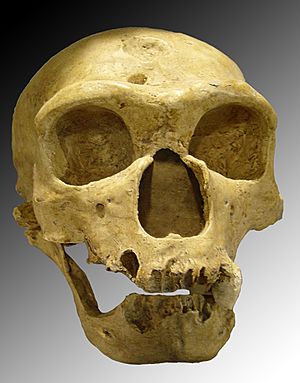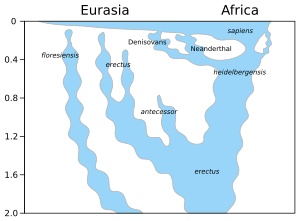Hominina facts for kids
Quick facts for kids HomininaTemporal range: Pliocene - present
|
|
|---|---|
 |
|
| Skull of Homo neanderthalensis | |
| Scientific classification | |
| Kingdom: | |
| Phylum: | |
| Class: | |
| Order: | |
| Superfamily: | |
| Family: | |
| Subfamily: | |
| Tribe: | |
| Subtribe: |
Hominina
|
| Genera | |
|
|
Hominina is a sub-tribe of the hominid primates. It is used by some anthropologists to include the upright biped apes, including the genus Homo.
If an anthropologist wants to includes chimpanzees in the tribe Hominini, then it follows that a sub-tribe is needed to put Australopithecines and humans in. But this is not a majority view at present, and the mainstream view is:
If used, the group includes Sahelanthropus six to eight million years ago.
Taxonomy
Even today, the genus Homo has not been properly defined.
Because there was no reason to think it would ever have any additional members, Carl Linnaeus did not even bother to define Homo when he first created it for humans in the 18th century. The discovery of Neanderthals brought the first addition.

The genus Homo was given its taxonomic name to suggest that its member species can be classified as human.
Over the decades of the 20th century, there were fossil finds of pre-human and early human species from late Miocene and early Pliocene times.
Classifying a fossil as Homo means evidence of:
- competent human bipedalism in Homo habilis inherited from the earlier Australopithecus of more than four million years ago, (see Laetoli);
- human tool culture having begun by 2.5 million years ago.
See also
 In Spanish: Hominina para niños
In Spanish: Hominina para niños

